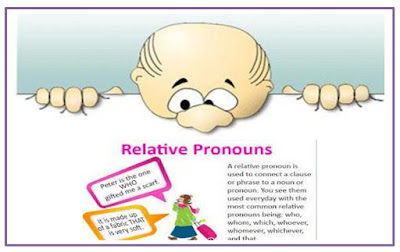Lesson Plan of Relative Pronouns English Grade VIII
Lesson Plan of Relative Pronouns
English Grade VIII
Students’ Learning Outcomes
·
Identify and demonstrate
function and use of relative pronouns which, who, and that.
Information for Teacher
·
Relative Pronoun: Relative pronoun is a word that connects two statements
and refers to a noun/pronoun within the sentence.
·
Relative Pronoun: is a word that is used to connect a clause or
phrase to a noun or pronoun.
(Zahra is the one who gifted
me a scarf)
(It is made of fabric that is
very soft)
·
Who: subject or object pronoun used for people
such as have you see the man who principle of
this college. Such as the horse which Ahmad was riding is very cute.
·
Who: is used for living things; which is used for
non-living things and animals, that can be used for person and things.
·
Which: subject or object pronoun used for animal
& things.
·
Which: is referring to whole things. Such as he
can’t read at all which didn’t surprise me.
·
Whose: possession for people, animal and things.
Such as have you see the boy whose mother was in class.
·
Whom: Object pronoun for the people in non-defining
relative clauses (in defining relative clauses we prefer to use who). Such as I
was invited by the Chairman whom I met at dinner party.
·
That: subject or object pronoun for people, animal
and things in defining relative clause. Such as I like the shoes that you wore
to the party last day.
·
A relative pronoun can be
used only in sentences with two clauses.
·
Relative pronouns: are words
that perform functions as other parts of speech also.
For example:
Who, whose, what, whom and
which are interrogative pronouns also as they are used to ask questions
1.
Who is coming to dinner
tonight?
2.
Which book are you reading?
3.
Who used all my paper?
4.
The person that phoned me
last night is my teacher.
Concept Map
Material / Resources
Charts, flash cards, marker/chalk, duster,
board
Worm up activity
·
Write 3 sentences on the
board in which relative pronouns have been used. Underline these relative
pronouns and ask the class what function they are performing.
I.
This is the essay that was
awarded the first prize.
II.
The boy who lost his book is
very worried.
III.
The goldfish which I bought
is swimming in the bowl.
·
Write the responses of the
students on the board.
Development
Activity 1
·
Join two sentences into one
by adding who, which and that; e.g.
I.
I saw the boy. The boy won
the race.
(I saw
the boy who won the race)
II.
Sana didn’t receive the
letter.
(Sana didn’t receive the letter which I wrote
to her)
III.
He built a cardboard house.
It was not strong.
(He built a cardboard house which was not
strong)
IV.
She broke the toy. It was
very expensive.
(She broke the toy which was very expensive)
V.
The girl is from Canada. She
is wearing jeans.
(The girl is from Canada who is wearing jeans)
VI.
I found the pen. I lost it
yesterday.
(I found the pen which I lost yesterday)
Activity 2
·
fill in the blanks with
suitable relative pronouns given below:
Who, Which, That
1.
The man _________ answered
the phone was rather rude.
2.
He always talks about the
things _______ impress the people.
3.
Where are the people
__________ ordered the taxi?
4.
Who has moved the papers
______ I left on my desk?
5.
You should complain to the
people _________ supplied it.
Answer key:
1.
Who, 2.That, 3.Who, 4.Which,
5.which
Sum up / Conclusion
·
Conclude the lesson by
writing the main points on the board.
Assessment
·
join the following pair of
sentences with suitable relative pronouns: Who, Which, That)
1.
I love the people. They serve
humanity.
(Expected response: I love the people who serve
humanity)
2.
He is looking for the pen. He
lost it yesterday.
(Expected response: He is looking for the pen
which he lost yesterday)
3.
Where is the main? He wrote
this interesting article.
(Expected response: Where is the man who wrote
this interesting article?)
4.
He answered the questions.
The questions were considered quit difficult.
(Expected response: He answered the question
that were considered quit difficult)
5.
She wanted to explore the
forest. The forest was still unexplored.
(Expected response: She wanted to explore the
forest that was still unexplored)
Follow u p
·
Ask the students to make five
sentence using relative pronouns which, who and that.





Very useful thanks indeed for the efforts you made to make me improve better
ReplyDeleteThank you for this.
ReplyDelete